What Kind Of Animals Live In The Desert
According to scientists, a desert is a place that gets less than x inches of rain every year. Nonetheless, non all deserts are alike. They can be stony, windblown deserts that are fairly inhospitable to living creatures. They can exist deserts that are full of plants, especially ones that have evolved to retain h2o such as cacti and other succulents. There are hot, sandy deserts called ergs. Much of the Sahara desert is an erg.
There are also temperate deserts that get just enough rain to back up woody shrubs but not grasses. Not all deserts are hot, and even Antarctica tin can exist thought of as a sort of desert. Even a hot desert can get surprisingly cool in the evenings. Animals all over the globe accept evolved to live in these deserts, and here are ten of them.
#ten Amazing Desert Animals: Dromedary Camel
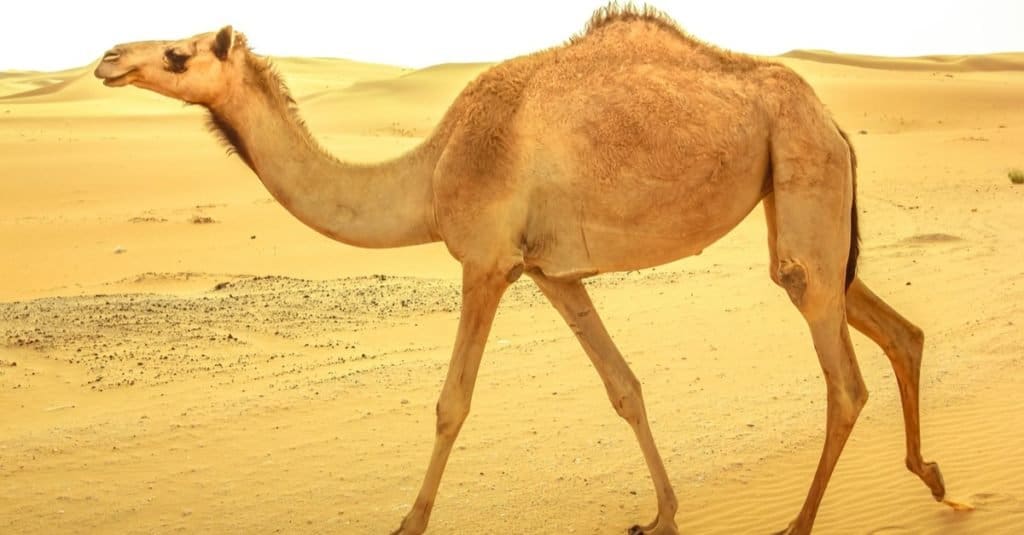
Benny Marty/Shutterstock.com
Called The Transport of the Desert, the camel is uniquely congenital to flourish fifty-fifty in the hottest and driest of deserts. An fauna that would very strange if it was not then familiar, the camel has a long, curving neck, a long tail, quite long legs that information technology can fold neatly under its body when it rests and a coat that comes in shades of brown, cream or sometimes blackness. Its body is 7.25 to 11 feet long, it stands between 5.6 and half-dozen.6 feet at the shoulder, and information technology weighs between 990 and 1210 pounds. Near of all, a well-fed camel has a hump. This hump is used to reserve fat, and the camel uses information technology when nutrient and water are scarce. Indeed, in absurd conditions, a camel can go for as long as seven months without a beverage.
The hump isn't the camel's only defense against the oestrus and dryness of the desert. It has a pocket-size caput and ears, and scorching air that enters its nostrils is cooled downwardly and humidified. The animal tin can also close its nostrils. The animal has thick eyebrows and a double row of eyelashes that protect its eyes from blowing sand. The dromedary, which has been extinct in the wild for nigh 4000 years, is found in Saharan Africa and western, southern, and central Asia. Many zoos exhibit dromedaries, including the Brevard Zoo, the San Diego Zoo, and the Louisville Zoo.
#9 Amazing Desert Animals: Scorpion
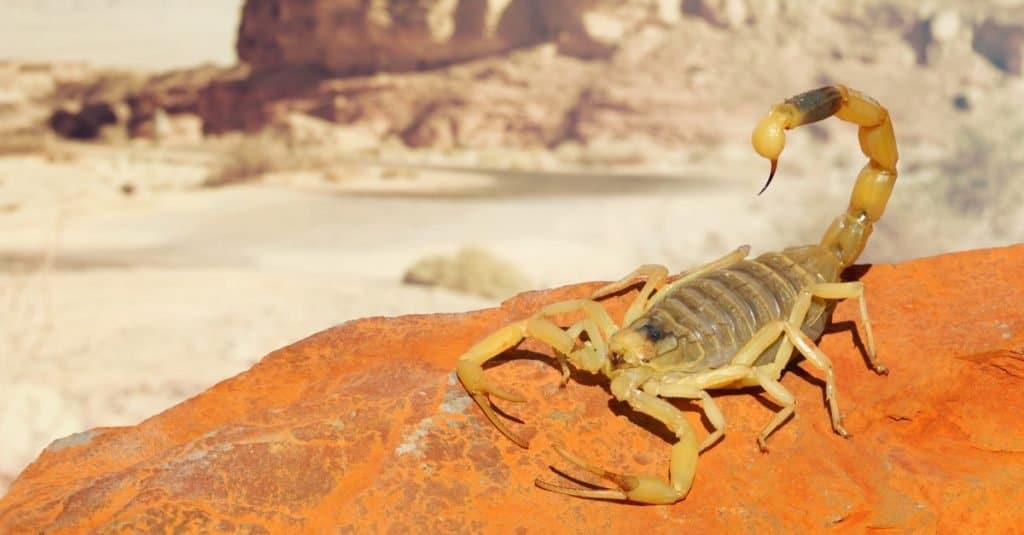
Protasov AN/Shutterstock.com
The scorpion is an arachnid, somewhat related to spiders. Like the spider, it has viii legs and venom, though the venom is delivered through a stinger in the tail. The tail is segmented and often carried curved over the animate being's body. The outset pair of legs end in pincers, and scorpions court by grasping each other's pincers and the male person "dancing" the female over to a sperm packet. Non merely this, these astonishing animals are fluorescent when exposed to UV light.
Found mostly in the desert, the scorpion is found on every continent save Antarctica. At that place are about 2500 species of scorpions, only only nearly 25 have venom powerful enough to impale a human. Still, these creatures however find themselves prey to other animals such as frogs, snakes, birds, lizards, spiders, and centipedes. Some predators are only immune to their venom while others have learned the fob of violent off the stinger earlier eating.
#eight Astonishing Desert Animals: Yucca Moth
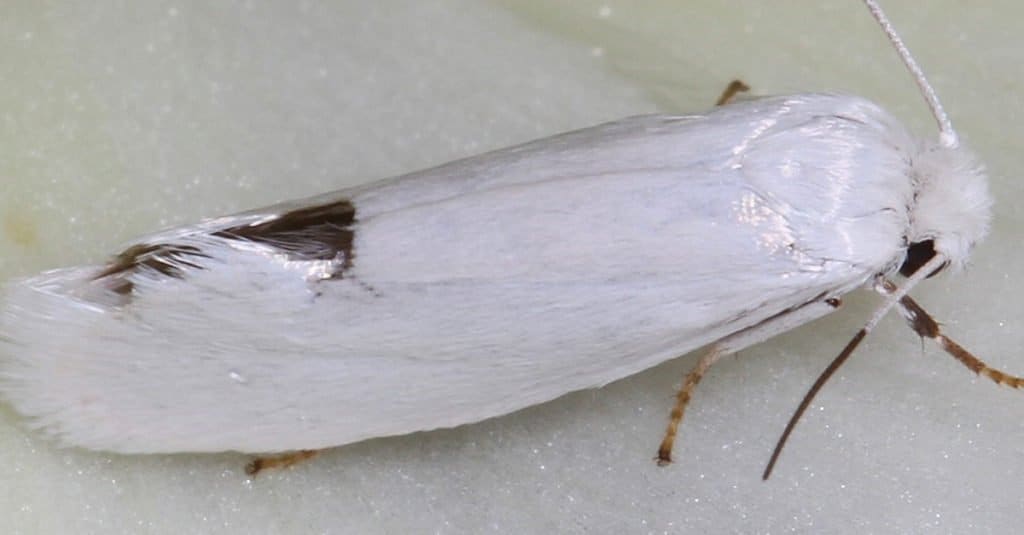
The yucca moth is a minor, white moth that helps pollinate the yucca, a plant that grows in the desert. Their colour camouflages them confronting the yucca bloom. The yucca and its moth are codependent and can't survive without each other. Each type of yucca has its own type of yucca moth that pollinates it. The moth either belongs to the Tegeticula or Parategeticula species.
The yucca moth differs from other moths in that information technology doesn't have a long, probing tongue. It has feelers effectually its oral fissure that don't assistance it feed, because the moth doesn't eat, but helps the females collect pollen. When she has a squeamish lump of pollen, she goes to another plant. She inspects the flowers there, and if there are no eggs in the ovary, she'll deposit a few, and add some pollen to the stigma of the blossom. This lets the flower produce fruit, which will in plough feed her caterpillars when they hatch.
After the caterpillar has hatched and fed on the fruit and seeds of the yucca, information technology falls to the ground, digs in, and weaves a cocoon around itself, where it volition stay till the next spring or longer. Whenever the new moth emerges, it will be at the aforementioned time that the yucca blossoms.
#seven Astonishing Desert Animals: Sidewinder
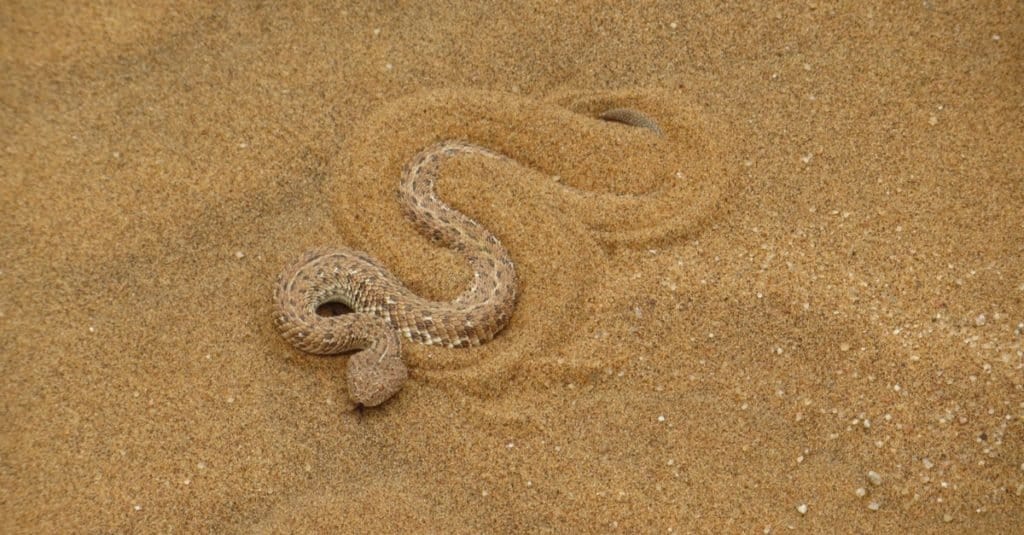
Roger de Montfort/Shutterstock.com
Another astonishing desert animate being is a serpent that moves through the sand sideways. There are several types of sidewinders. The Peringuey'south desert adder lives in Angola and Namibia and some other, the Saharan horned viper, lives in northern Africa, the Levant, and the Arabian peninsula. The Saharan horned viper is between one and two feet long, with females larger than the males. They are known for the horns over their eyes. The colors of their scales friction match the color of the sand and make them hard to see. They prefer the rockier parts of the desert and can also exist found in oases.
Peringuey's desert adder is smaller than the Saharan horned viper, and the biggest ones are no longer than 13 inches. Like the Saharan serpent, its trunk is colored to help information technology alloy in with the sand, though the tip of the tail is black. This helps to lure casualty as information technology sticks upwardly out of the sand where the snake is hiding.
#6 Amazing Desert Animals: Roadrunner
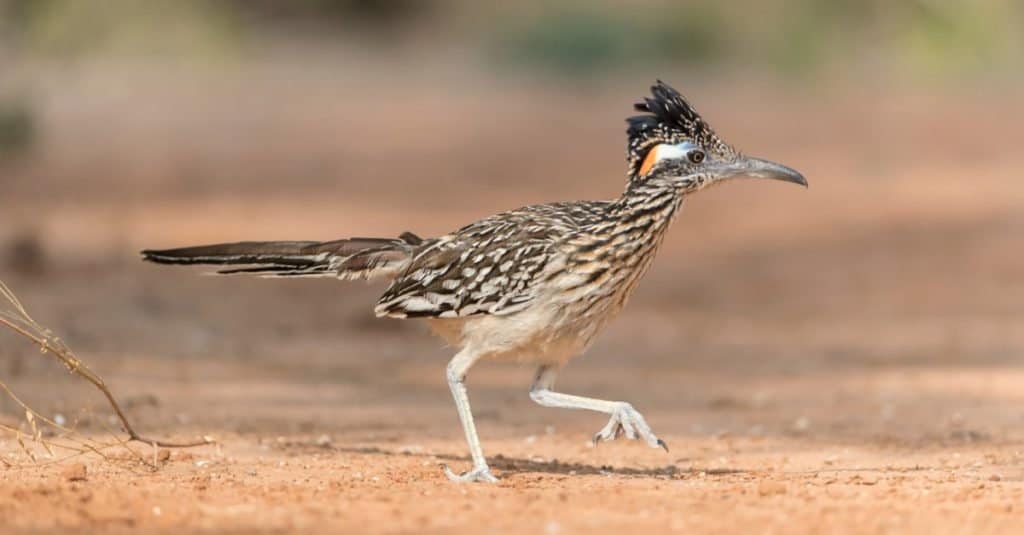
Dennis Due west Donohue/Shutterstock.com
The roadrunner is a type of basis cuckoo and is notable for its swiftness on land. It can run as fast equally 20 miles per hr or even faster, only it will fly abroad if it must. Roadrunners are about 2 feet long from their beak to their tail and weigh near 8 to 15 ounces. They are unmistakable with their crest, their long legs and long tail, and dark-brown, black, and white feathers. The roadrunner is an omnivore and will swallow anything it can handle, including rattlesnakes, lizards, snails, smaller birds, and stinging insects such as the tarantula militarist. It runs down its prey and may bash it to death against the ground before eating it.
#5 Amazing Desert Animals: Saiga
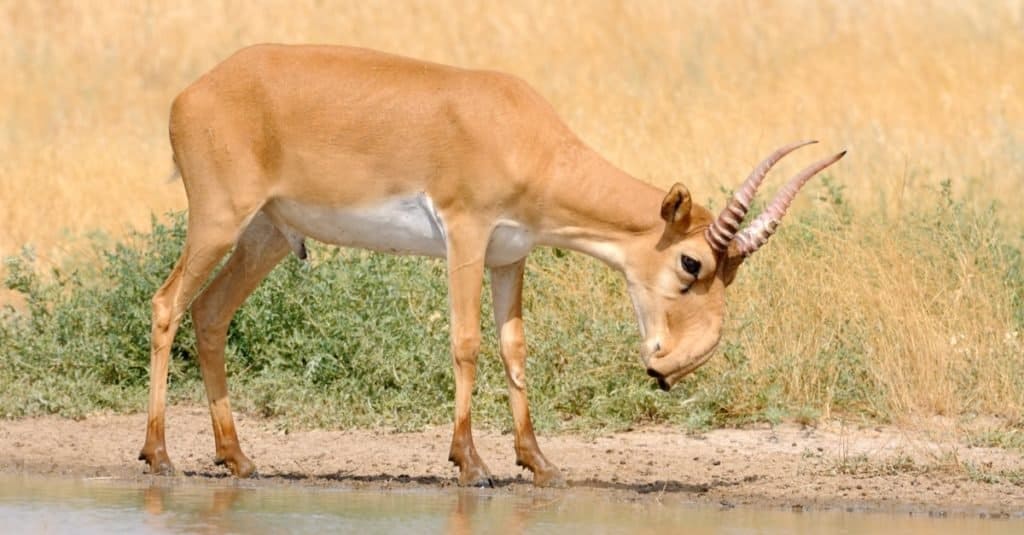
This antelope is famous for its large, Roman nose with nostrils that signal toward the ground. This positioning helps the animal cool downwardly the air that enters its nose in the summertime, and warm it up in the winter. The saiga is critically endangered and found in Russia, Kazakhstan, with a subspecies in western Mongolia. The coat of this brute, which is about 3.25 to 4.five feet long and weighs betwixt 57 and 150 pounds, is buff. It grows whiter and much thicker during the wintertime.
Only male saiga have horns, and they are ridged and a bit translucent. The horns of the Russian animals tin can be as long equally 15 inches while those of the Mongolian saiga are shorter. Like wildebeests, they are also famous for their long migrations, which tin cross rivers and embrace hundreds of miles. Saigas can exist seen at the San Diego Zoo.
#4 Astonishing Desert Animals: Antelope Jackrabbit
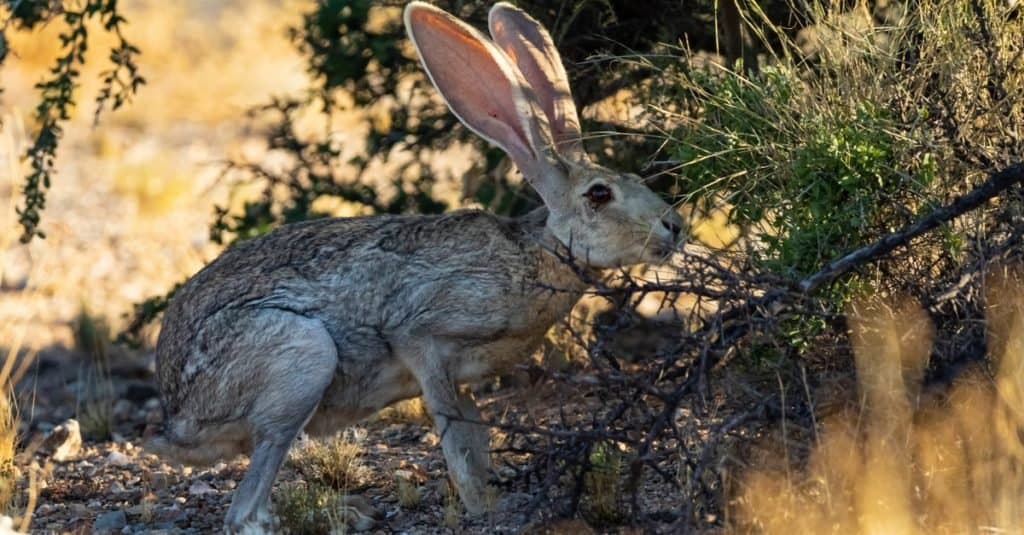
Vincent Pro Photo/Shutterstock.com
The antelope jackrabbit, which is really a hare, lives in the deserts of southern Arizona and the northwest surface area of Mexico. It prefers areas that have desert shrubs that shade grasses but can also be found in more desolate regions. It is a large hare with grey flanks, a black dorsum, and orange on its chest and neck. It has a white belly and can be most 22 inches long with a iii-inch long tail. It can counterbalance as much as nine pounds and has unusually long ears fifty-fifty for a rabbit or a hare. It easts cacti and other plant material and has sometimes been seen eating the soil for minerals.
#iii Amazing Desert Animals: Tadpole Shrimp
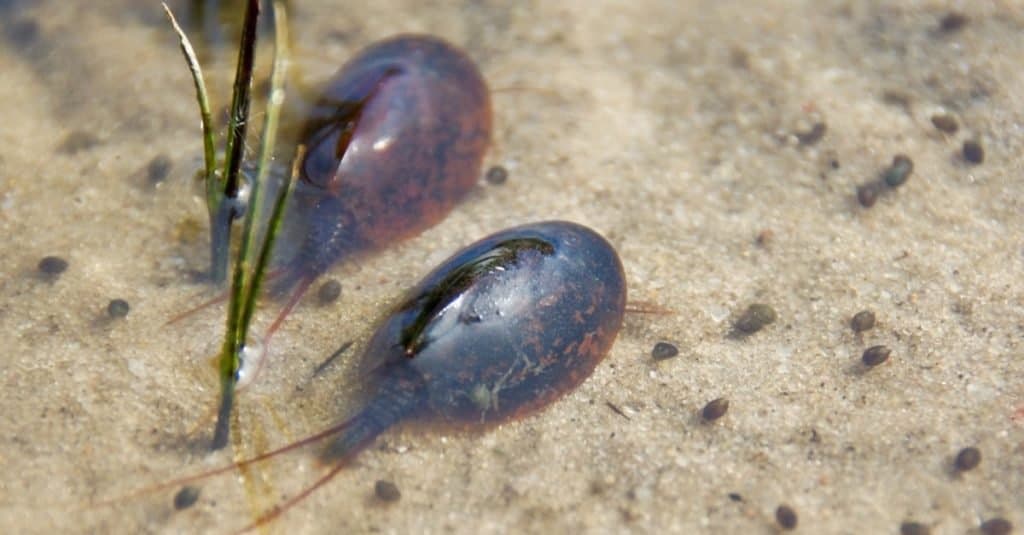
Repina Valeriya/Shutterstock.com
This animal is tiny compared to the other animals described here, simply it is no less astonishing. Found in the family Triopsidae, polliwog shrimp accept not changed much since the Triassic era, which began about 252 million years agone. They indeed wait like tiny trilobites and range from .08 to 3.9 inches long. They are institute around the world, and some take advantage of arroyos, which are dry stream beds plant in deserts that fill up upwardly when it finally rains.
A female lays her eggs in the mud at the bottom of the puddle, just if she senses that the pool will shortly dry upwardly, she'll have the eggs go dormant. If there is enough water in the pool, the eggs will hatch, start to molt, and molt a few more times until it is an adult. This only takes a few days, and the tadpole shrimp is by so an adult, prepare to lay eggs and start the cycle over again.
#2 Amazing Desert Animals: Merriam'southward Kangaroo Rat
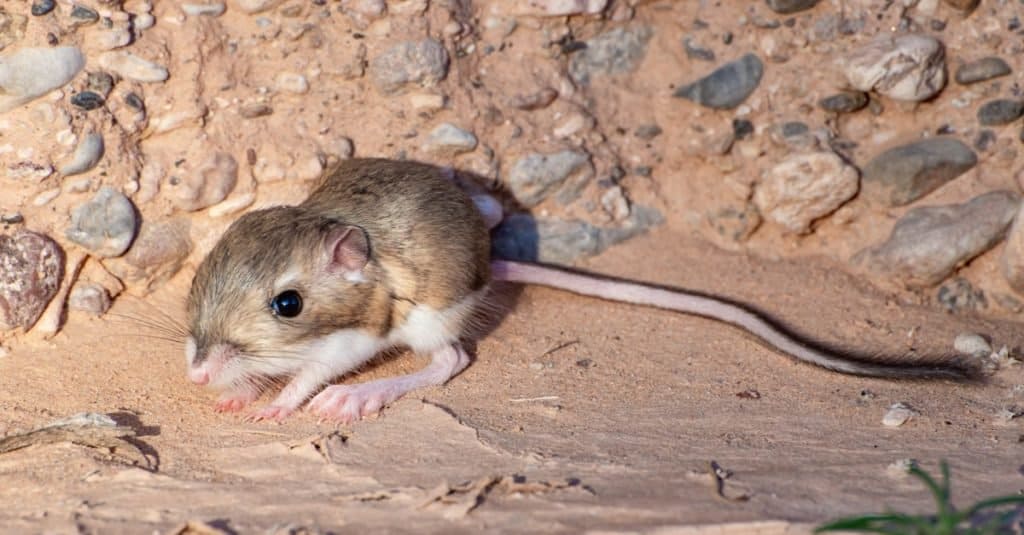
Dominic Gentilcore PhD/Shutterstock.com
The kangaroo rat gets its proper name because information technology has large strong hind legs that remind people of a kangaroo, even though they're non at all related. In improver to its powerful legs that permit information technology hop over the deserts of the southwestern Us and United mexican states, the kangaroo rat's tail is longer than its 4-inch long body and helps remainder it. Information technology burrows into the sand to search for food such as seeds of the prickly pear, ocotillo, and mesquite. It caches these seeds in its couch. The Merriam kangaroo rat prefers stony deserts, though it also flourishes in dirt, sand, and gravel deserts.
#1 Amazing Desert Animals: Sand Cat
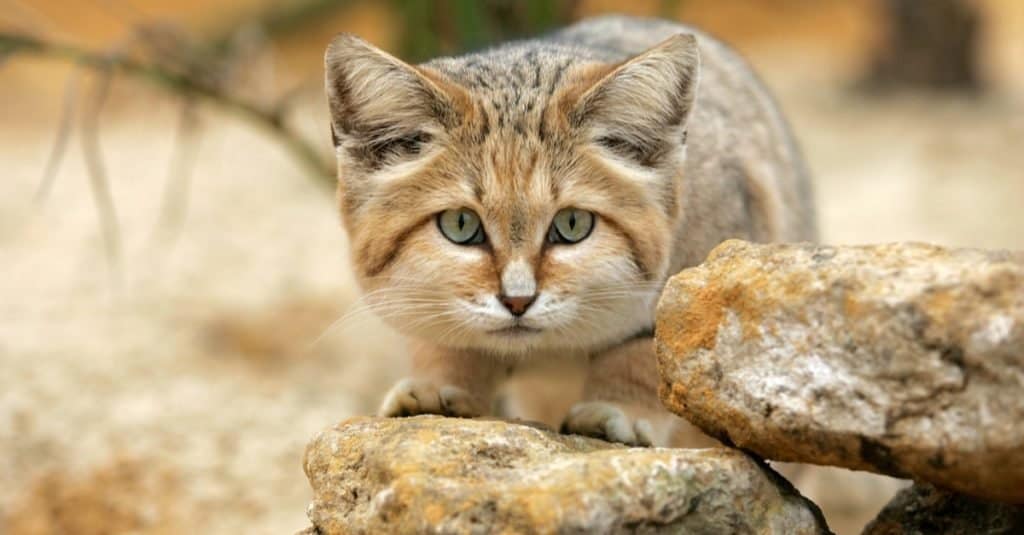
slowmotiongli/Shutterstock.com
Like other desert creatures, the sand cat of north Africa and west, central and south Asia has evolved to need very lilliputian water. It gets well-nigh of its wet from its food, which consists of smaller mammals such as jerboas, birds, and reptiles. It'southward small for a wild cat, with a length of between xviii and 22.5 inches and a weight betwixt iii.25 and 7.75 pounds. Information technology has a sand-colored glaze with black stripes on its legs with a crimson streak that runs from the corner of its eye to its cheek. Information technology is nocturnal and rests in a burrow during the day.
Adjacent Upwards: Top 10 Scariest Animals in The World
Source: https://a-z-animals.com/blog/the-10-most-amazing-desert-animals/
Posted by: jacksonhatur1943.blogspot.com

0 Response to "What Kind Of Animals Live In The Desert"
Post a Comment